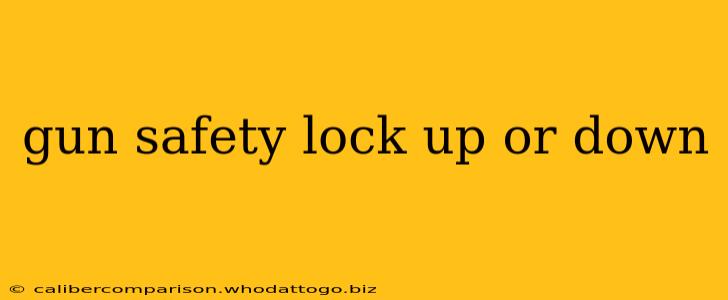Gun safety is paramount, and a crucial aspect of responsible gun ownership involves secure storage. The question of whether to keep your firearm's safety "up" or "down" when stored is a nuanced one, depending heavily on the specific firearm, your storage method, and your individual risk assessment. This guide will help you understand the different approaches and determine the safest option for your circumstances.
Understanding Firearm Safeties
Before diving into the "up" or "down" debate, it's essential to understand the different types of firearm safeties and how they function. Safeties are mechanical devices designed to prevent accidental discharge. Their operation varies widely depending on the firearm's make, model, and even the specific year of manufacture. Some common types include:
- Manual Safeties: These are typically levers or buttons that must be manually engaged to render the firearm inoperable. They can be located in various positions – on the slide, frame, or trigger guard.
- Grip Safeties: These safeties only allow the firearm to fire when held correctly, preventing discharge if dropped or mishandled.
- Drop Safeties: These internal mechanisms prevent accidental firing if the firearm is dropped. Note that while these offer a degree of protection, they are not foolproof.
It is crucial to consult your firearm's owner's manual. This manual will detail the specific safety features of your gun, how they operate, and the manufacturer's recommended handling procedures. Ignoring your firearm's manual can be dangerous.
The "Up" vs. "Down" Debate: A Closer Look
The question of whether to leave the safety "up" (engaged) or "down" (disengaged) when storing a firearm is often debated. There's no universally correct answer. Here’s a breakdown of the considerations:
Arguments for Keeping the Safety "Up" (Engaged):
- Reduced Risk of Accidental Discharge: This is the most prominent argument. With the safety engaged, the firearm is less likely to fire accidentally, even if mishandled.
- Added Layer of Security: In conjunction with other storage methods like gun safes or trigger locks, an engaged safety adds another layer of protection against unauthorized access and accidental discharge.
Arguments for Keeping the Safety "Down" (Disengaged):
- Faster Response Time in Emergencies: Some argue that having the safety disengaged allows for quicker access and use of the firearm in a self-defense situation. However, this benefit is significantly outweighed by the risks involved unless the gun is stored in a secure location.
- Potential for Malfunction: In some firearms, the safety mechanism itself can malfunction, potentially hindering the firearm's proper operation when needed. This is a rare occurrence but should be considered.
The Safest Approach: Secure Storage and Responsible Handling
Regardless of whether you choose to leave the safety "up" or "down," the most critical element of gun safety is secure storage. This far outweighs the relatively minor difference between an engaged or disengaged safety. Best practices include:
- Gun Safes: Investing in a high-quality gun safe is the best way to protect your firearms from unauthorized access and accidental discharge.
- Trigger Locks: These devices physically block the trigger, preventing the firearm from being fired. They should be used in conjunction with other storage methods.
- Separate Ammunition Storage: Store ammunition separately from firearms, preferably in a locked container.
- Education and Training: Proper gun safety education and training are essential for all gun owners.
Conclusion: Prioritize Secure Storage Above All Else
The "up" or "down" safety debate is secondary to the much more important issue of secure storage and responsible handling. While keeping the safety engaged provides an extra layer of protection, the ultimate goal is to prevent accidental discharge and unauthorized access. Consult your firearm's manual, prioritize secure storage, and always practice safe gun handling. Remember, responsible gun ownership requires constant vigilance and adherence to best practices. Your safety and the safety of those around you depend on it.

